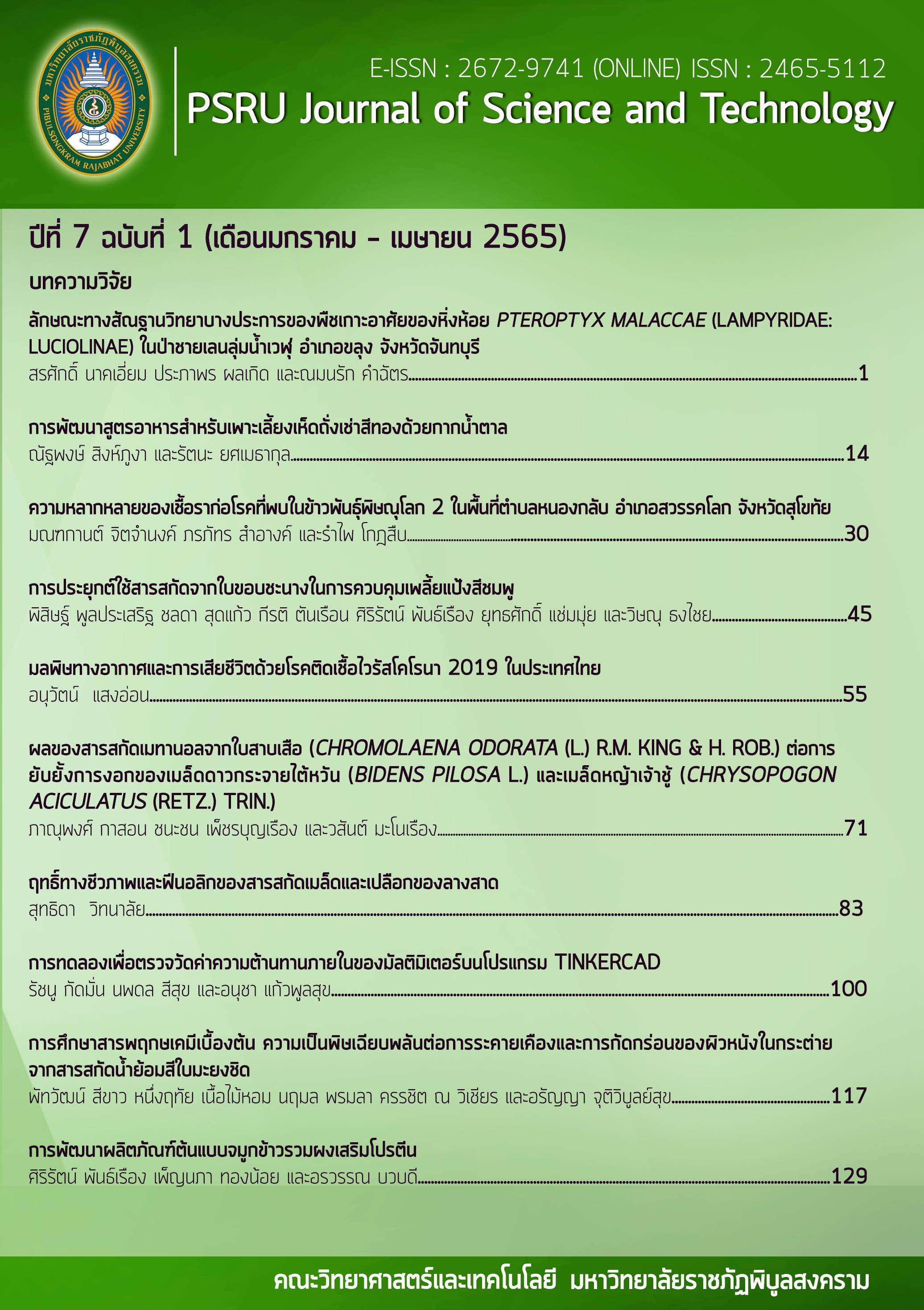DEVELOPMENT OF CULTURE MEDIA FOR CORDYCEPS MILITARIS CULTIVATION WITH MOLASSES
Keywords:
การเพาะเลี้ยงเห็ดถั่งเช่าสีทอง , กากน้ำตาล, สูตรอาหารเพาะเลี้ยงAbstract
The objective of this study was studied to effect of culture medium mixed with molasses and protein sources that were silkworm pupa and milk powder on yield and bioactive compound production of Cordyceps militaris. The experiment design was done by using Completely Randomized Design with 3 replications, 3 bottles each. C. militaris was cultivated on 14 formulas solid media for 65 days. Results showed that the formula 10 (30 g of Sao Hai rice mixed with 50 mL of molasses 5% w/v and 5 g of silkworm pupa) showed the highest yield and bioactive compound production. The number of fruiting bodies and fresh weight had 61.15 fruit bodies/bottle and 42.39 g/bottle, respectively. The shape of fruiting bodies was longer than fruiting bodies in other formulas (6.44 cm). The color that expressed in lightness (L*), red (a*) and yellow (b*) were 56.27, 23.67 and 47.81, respectively. The content of bioactive components, adenosine and cordycepin were 1,853.85 and 2,255.47 mg/kg, respectively.
References
ธัญญา ทะพิงค์แก, มงคล ยะไชย, ศุภชัย ศรีธิวงค์, กัญจน์พัชร์ อุปลศิลป์, อภิรดา พรปัณณวิช, อภิชญา ทองทับ, และวรรณพร ทะพิงค์แก. (2557). การศึกษาการเพาะเลี้ยงเห็ดสมุนไพร ถั่งเช่าสีทองและการนำไปใช้ประโยชน์ (รายงานการวิจัย) เชียงใหม่: มหาวิทยาลัยราชภัฏเชียงใหม่.
นันทยา จงใจเทศ, พิมพร วัชรางค์กุล, ปิยนันท์ เผ่าม่วง และเพ็ญพโยม ประภาศิริ. 2549. สำนักโภชนาการ “คุณภาพโปรตีนและ ไขมันในแมลงที่กินได้”. สืบค้นเมื่อ 15 มีนาคม 2564, จาก http://nutrition.anamai.moph.go.th/temp/main/view.php?group=&id=120
รัฐพล ศรประเสริฐ. 2539. การศึกษาปัจจัยที่มีผลต่อการเจริญของเส้นใยเห็ดฟางในอาหารเหลว. อาหาร, (26)2, 98–107.
รัฐพล ศรประเสริฐ, อนงคณ์ หัมพานนท์, และสยาม อรุณศรีมรกต. (2559). การเพาะเลี้ยง Cordyceps militaris ด้วยเมล็ดธัญพืชและแมลงในท้องถิ่นและประสิทธิภาพการยั้งเชื้อ Trichophyton rubrum และ Staphylococcus aureus. วารสารวิชาการพระจอมเกล้าพระนครเหนือ, 26(2), 239–251.
สำนักวิจัยและพัฒนาข้าว กรมการข้าว. (2558). องค์ความรู้เรื่องข้าว. สืบค้นเมื่อ 25 มกราคม 2564, จาก http://www.brrd.in.th/rkb2/postharvest/index.php-file=content.php&id=6.htm
Dai, G. W., Bao, T. T., Xu, G. F., Cooper, R. & Zhu, G X. (2001). CordyMax TM Cs-4 improves steady-state bioenergy status in mouse liver. Journal of Integrative and Complementary Medicine, 7, 231–240.
Dong, C.H., & Yao, Y.J. (2008). In vitro evaluation of antioxidant activities of aqueous extracts from natural and cultured mycelia of Cordyceps sinensis, LWT - Food Science and Technology, 41, 669–77.
Dong, Z.J., Wangb, H.S., Aia, R.X., Yaoa, L., Suna, W.Z., Leia, C., Wang, Y., & Wang, Q. (2013). Composition and characterization of cordyxanthins from Cordyceps militaris fruit bodies. Journal of Functional Foods, 5, 1450–1455.
Freeman, S. (2011). Biological Science (4th ed). CA: Pearson Benjamin Cumming.
Huang, L., Li, Q., Chen, Y., Wang, X., & Zho, X. (2009). Determination and analysis of cordycepin and adenosine in products of Cordyceps spp. African Journal of Microbiology Research, 3(12), 957–961.
Imrite, F.K.E. (1969). Fermentation media sugar and molasses processes. Biochemistry, 4(1), 34–35.
Kitakaze, M., & Hori, M., (2000). Adenosine therapy: a new approach to chronic heart failure. Expert Opinion on Investigational Drugs. 9, 2519–2535.
Kim, S-Y., Shrestha, B., Sung, G-H., Han, S-K., & Sung, J-M. (2010). Optimum Conditions for Artificial Fruiting Body Formation of Cordyceps cardinalis. Mycobiology, 38(2), 133–136.
Lee, H. J., Burger, P., Vogel, M., Friese, K., & Bruning, A. (2012). The nucleoside antagonist cordycepin causes DNA double strand breaks in breast cancer cells. Investigational New Drugs, 30, 1917–1925.
Li, C., Li, Z., Fan, M., Cheng, W., Long, Y., Ding, T., & Ming, L. (2006). The composition of Hirsutella sinensis, anamorph of Cordyceps sinensis. Journal of Food Composition and Analysis, 19(8), 800–805.
Lilly, V.G., & Barnett, H.L. (1951). Physiology of the fungi. London: Mc Graw–Hill Book Company.
Lim, K., Lee, C.H., & Chang, E. (2012). Optimization of solid state culture condition for the production of adenosine, cordycepin, and d-mannitol in fruiting bodies of medicinal caterpillar fungus Codyceps militaris (L.:Fr.) Link (Ascomycetes). International Journal of Medicinal Mushrooms, 14(2), 181–187.
Masuda, M., Urabe, E., Sakurai, A., & Sakakibara, M. (2006). Production of cordycepin by surface culture using the medicinal mushroom Codyceps militaris. Enzyme and Microbial Technology, 39, 641-646.
Nakamura, K., Konoha, K., Yoshikawa, N., Yamaguchi, Y., Kagota, S., Shinozuka, K., & Kunitomo, M. (2005). Effect of cordycepin (3'-deoxyadenosine) on hematogenic lung metastatic model mice. In Vivo, 19, 137–141.
Schmidt, K., Li, Z., Schubert, B., Huang, B., Stoyanova, S., & Hamburger, M. (2003). Screening of entomopathogenic deuteromycetes for activities on targets involved in degenerative diseaces of the central nervous system. Journal of Ethnopharmacology, 89(2-3), 288–297.
Shrestha, B., Lee, W.H., Han, S.K., & Sung, J.M. (2006). Observation on some of the mycelial growth
the pigmentation characteristics of Cordyceps militalis isolate. Microbiology, 34(2), 83–91.
Stoppok, E., & K. Buchholz. (1993). Sugar-Based Raw Materials for Fermentation Application, pp. 5-29. In G. Stephanopoulos, eds. Biotechnology Volume 3 Bioprocessing. VCH Publishers Inc., New York.
Weil, M.K., & Chen, A.P. (2011). PARP inhibitor treatment in ovarian and breast cancer. Current Problems in Cancer, 35, 7–50.
Yoshikawa, N., Nakamura, K., Yamaguchi, Y., Kagota, S., Shinozuka, K., & Kunitomo, M. (2004). Antitumour activity of cordycepin in mice. Clinical and Experimental Pharmacology and Physi, 31, S51–3.
Yu, H. M., Wang, B.-S., Huang, S.C., & Duh, P.D. (2006). Comparison of protective effects between cultured Cordyceps militaris and natural Codyceps sinensis against oxidative damage. Journal of Agricultural and Food Chemistry, 54(8), 3138–3188.
Zheng, P., Xia, Y., Xiao, G., Xiong, C., Hu, X., Zhang, S., Zheng, H., Huang Y., Zhou, Y., Wang, S., Zhao, G.P., Liu, X., Leger, J. St. R., & Wang, C. (2011). Genome sequence of the insect pathogenic fungus Cordyceps militaris, a valued traditional chinese medicine. Genome Biology, 12, R116.
Downloads
Published
How to Cite
Issue
Section
License
Copyright (c) 2022 PSRU Journal of Science and Technology

This work is licensed under a Creative Commons Attribution-NonCommercial-NoDerivatives 4.0 International License.
กองบรรณาธิการขอสงวนสิทธิ์ในการปรับปรุงแก้ไขตัวอักษรและคำสะกดต่างๆ ที่ไม่ถูกต้อง และต้นฉบับที่ได้รับการตีพิมพ์ในวารสาร PSRU Journal of Science and Technology ถือเป็นกรรมสิทธิ์ของคณะวิทยาศาสตร์และเทคโนโลยี มหาวิทยาลัยราชภัฏพิบูลสงคราม และ
ผลการพิจารณาคัดเลือกบทความตีพิมพ์ในวารสารให้ถือมติของกองบรรณาธิการเป็นที่สิ้นสุด







